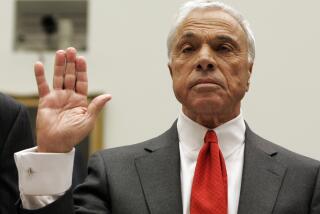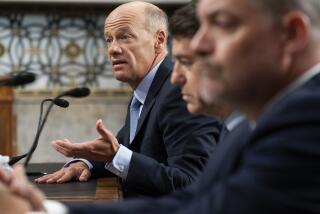Banking Regulator Warns of S&L; Crisis ‘Meltdown’
- Share via
WASHINGTON — Warning that the savings and loan crisis could cause a “financial meltdown,” L. William Seidman, the nation’s top bank regulator, called Wednesday for spending $30 billion in 1989 to shut down more than 100 of the “worst losers” in the S & L industry.
“We need to close the worst first,” Seidman said in a National Press Club speech, giving a sense of urgency to the growing debate over the best way to manage the thrift crisis.
Seidman, as chairman of the Federal Deposit Insurance Corp., oversees the fund that insures commercial bank deposits up to $100,000. His insurance program is much healthier financially than the federal program protecting savings and loan deposits up to $100,000.
Seidman is anxious to block any plans to merge the two funds and has repeatedly offered evaluations of the S & L crisis much more pessimistic than the views of the Federal Home Loan Bank Board, which regulates S & Ls.
The total cost of cleaning up the failed thrifts will range between $50 billion and $100 billion, and “our own estimates tend toward the higher end of that range,” Seidman said.
At the Federal Home Loan Bank Board, the most recent estimate is that the rescue will cost $45 to $50 billion. Regulators there insist that the money can be supplied through premiums collected from healthy S & Ls. However, this would require extending a special assessment on the industry for 30 years, and would seriously harm the healthy institutions, bank board officials acknowledge.
Privately, however, bank board experts are analyzing proposals that could involve some expenditure of taxpayer funds to deal with the crisis.
Seidman’s blunt remarks Wednesday seem certain to undercut even more the bank board’s already damaged credibility with a skeptical Congress.
By calling for the massive expenditure of $30 billion almost immediately, Seidman is saying that the crisis calls for an extraordinary bailout by the taxpayers of an important U.S. industry. Some money would come from the industry, but the great bulk would have to be furnished by congressional action--and that means taxpayer money.
“The thrift industry’s problems alone now demand funding on a massive scale,” Seidman said. “That funding requirement appears to exceed the combined resources devoted to Europe under the Marshall Plan, and the bailout of Lockheed, Chrysler, Penn Central and New York City.”
Two Uses for Money
The money would be used in two ways: to pay off the depositors of institutions that will be shut down, and to provide financial guarantees for investors who agree to take control of ailing thrifts through mergers and combinations.
These funds would flow into the Federal Savings and Loan Insurance Corp., the insurance fund now suffering a substantial deficit. “A deposit insurance system out of control has the potential to ‘melt down’ and damage the entire economy,” Seidman said.
The bank regulator did not endorse any specific plan to raise the $30 billion, saying: “It’s up to the Treasury Department and Congress to determine which alternative makes the most sense in the overall federal planning. The message today is, the situation requires $30 billion in 1989.”
In contrast to the debt-ridden S & L insurance fund, Seidman’s bank protection fund will end this year with a healthy $15-billion surplus.
He diplomatically but unmistakably rejected any suggestions that the bank fund be combined with the S & L deposit insurance fund to provide an infusion of desperately needed cash for the FSLIC.
The FDIC, he said, “would prefer going it alone.”
The agency “is one of the few examples of a government institution that has proven able to save for a rainy day,” he said. “It has not only done so, but it has used its savings to weather one of the biggest storms ever, and emerge from the tempest slightly damp but dry enough to be ready for the next storm.”
Seidman said his agency is ready to offer its “supervisory and liquidation skills” to help dispose of insolvent S & Ls.
Rep. Henry B. Gonzalez (D-Tex.), who is expected to become chairman of the House Banking Committee next year, agreed with Seidman that the crisis demands fast action.
“Every day that goes by the problem gets bigger,” Gonzalez said. “It compounds . . . as long as these institutions that are dead as a doornail are still there.”
Gonzalez has proposed that the Treasury provide a $50-billion loan over a 20-year period to the Federal Savings and Loan Insurance Corp., a less dramatic plan than Seidman’s single shot of $30 billion.
‘Stop Bloodletting’
“I believe it wouldn’t even take $30 billion to do what has to be done--and that’s stop the bloodletting,” Gonzalez said. Gonzalez and other members of Congress are anxious to avoid any solution that could worsen the federal budget deficit.
In addition to his call for immediate outlays of $30 billion, Seidman offered a package of ideas to improve the nation’s deposit insurance system. He recommended:
--A separate budget for the insurance funds to retain any unspent premium income in the funds available for bad times. Until the current crisis hit, the money was deposited in the Treasury.
--Variable insurance premium rates for federal deposit protection, depending on the health of the fund, and of individual financial institutions.
--Authority for the funds to terminate insurance if an institution does not behave in a financially responsible manner.
--Adoption of standard accounting principles for all institutions. S & Ls now have available more forgiving accounting standards under the bank board’s regulatory system.
More to Read
Inside the business of entertainment
The Wide Shot brings you news, analysis and insights on everything from streaming wars to production — and what it all means for the future.
You may occasionally receive promotional content from the Los Angeles Times.










